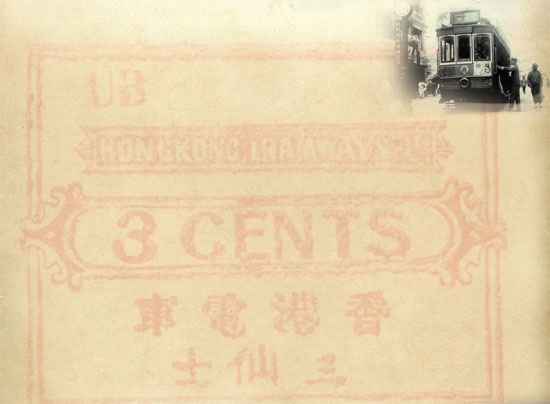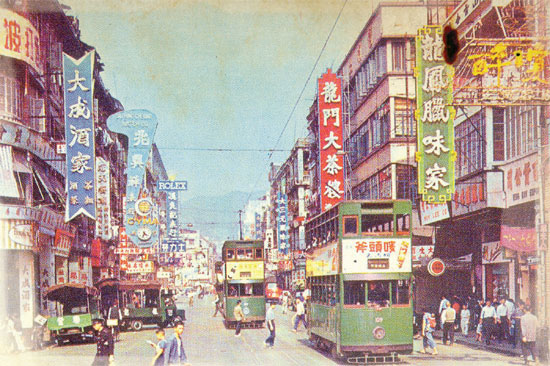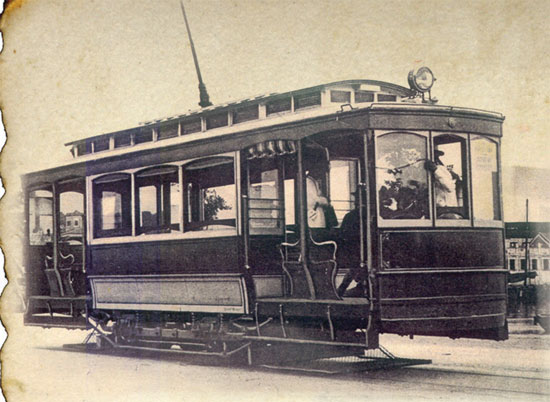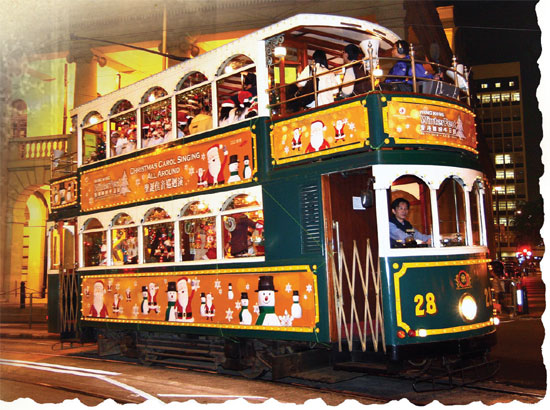One hundred years of double-decker Ding Dings
Updated: 2012-11-22 05:55
By Manpreet Singh(HK Edition)
|
|||||||||
|
Street view of the 1960's. Today, there are 120 tram stops from Shau Kei Wan to Kennedy Town, which generally are located at an interval of around 250 meters on average. |
|
A first-generation tram in Hong Kong. The tram service began with a fleet of 26 single-deck tram cars in 1904. All Photos Provided to China Daily |

Serving for over a century, trams run to its 100th anniversary in Hong Kong. With the largest fleet of double-decker cars in the world, Ding Dings keep offering cheap but remarkable trips amid the maddening, fast-paced city life. Manpreet Singh reports.
Leung Kwan, 85, takes a tram almost every second day from her home in Tin Hau to Causeway Bay, either to buy groceries and vegetables, or just to enjoy yum cha. She enjoys the ride and the views, leisurely observing the world go by.
"I love trams because they match my pace. They have been my constant companions for so many years that I've lost count of them," she says. "Besides, they are cheap to travel in." Leung takes MTR only on rare occasions, particularly when she has to "visit her friends or relatives living in faraway places".
A young executive, Henry Chan, uses the tram just below his residential building in Wan Chai to reach office in Central almost every working day. "It's very convenient for me, as the tram drops me just right in front of my office," says Henry.
Trams are the preferred mode of transportation for housewife Lai Lai-ping, 64, who likes to travel in them exclusively. "I always take a tram from Causeway Bay to Central for shopping. It is too much of a hassle to walk the long way to get an MTR. The tram is very convenient and cheap as well."
Serving Hong Kong for over a century, it is not without reason that trams are often called the "grandfather to Hong Kong's world renowned public transport system". This year marks the 100th anniversary of double-decker trams in Hong Kong. The city has the largest fleet of double-decker tram cars in the world still in service, and its tram system runs exclusively on double-deckers.
Locals lovingly refer to trams as Ding Dings, for the sound of their double-bell ring, which the tram drivers have used to warn pedestrians for over a century on busy Hong Kong streets.
It is said that trams caused a sensation when they were first introduced and people would flock to the tram lanes just to get a look at them. Trams were also obstructed by hawkers who would drag their heavy carts on the tram tracks, following which the authorities in 1911 passed a law, banning carts with the same wheel gauge as the trams. That law still applies today.
"The trams are a glorious bridge between the city's history and the present," says Guy Lipert, an expat who has been living in Hong Kong for some years. "It is a great experience to commute or just a take ride on them."
The trams' journey began with a fleet of 26 single-deck tram cars in 1904, when Hong Kong was a laid-back and sleepy British colony, compared to its current status of a happening world-class metropolis renowned as Asia's World City. Amid a maddening, fast-paced life, the trams offer a remarkable contrast in following a steady pace, surrounded by the city's tallest skyscrapers and the narrowest streets and roads handling trams, anywhere in the world.
Today, the fleet of 163 double-decker trams (which includes two antique tramcars) ferry 210,000 passengers a day. With a flat fare of just HK$2.30 (HK$1.10 for senior citizens aged 65 or above), they take you from one end to the other. The trams are numbered up to 170, with certain numbers missing owing to local superstitions or accidents.
Trams cover six routes (totalling 30km) along the north side of Hong Kong Island, providing service between Shau Kei Wan, Happy Valley and Kennedy Town from early morning to midnight. The Happy Valley single-track "loop" runs three kilometers. There are 120 tram stops from Shau Kei Wan to Kennedy Town, which generally are located at an interval of around 250 meters on average.
The seventh-generation trams were launched last November, with a new style interior that gives trams a more modern, stylish look with the traditional tram exterior. The trams wooden bodies are replaced with aluminum ones.
Over the years, trams also have come to reflect Hong Kong's economic prosperity. After a French company bought the Hong Kong Tramways in 2010, the trams have been transformed. Their earlier, utilitarian look is replaced with a new look that is truly colorful. World-class top brands are advertised in dazzling displays on the sides of trams and at tram-stop shelters the name brand advertising lends new color to the already vibrant city that Hong Kong is.
"Tram advertising helps us to earn and support our operations, without putting pressure on passenger fares. Just imagine, after 30 years of no change in fares, it was increased from HK$2 to HK$2.30, a mere 15 percent increase," says Tsang Wing-hang, managing director of Hong Kong Tramways.
On the company's proposal to increasing fares, a Hong Kong Island lawmaker reacted by saying that the main reason many passengers - especially the elderly, students and maids - took the tram was because it had the cheapest fares, and people who used the tram didn't care much if it was slow, noisy and without air conditioning.
Slow speed, though an advantage with the elderly passengers whose numbers are growing by the day, remains the major sore point with pragmatic youngsters and tram critics. While generally evoking admiration, the trams are criticized by some as a "nostalgic nuisance" or "the remaining black spots" on Hong Kong's otherwise, most efficient public transportation system.
"I think the nostalgia about trams is much hyped," says Herman, a college student. "Trams create noise pollution and make the traffic slower. Traffic in Hong Kong without them could be a little faster."
Professor Dennis Leung, chairman of the Transport & Environment Committee, Institute of Transport Studies of Hong Kong University, says the tram survives and attracts passengers, because it is the cheapest transportation mode.
"Their speed is a bit slow but trams are one of the safest transports in Hong Kong," says Professor Leung. "It is a bit hot during summer days, other than that my experiences on trams are very good, particularly for short trips. The speed could be enhanced."
"If allowed to run freely, trams can run at 50km/h, but at present their commercial speed is less than 10km/h," says Tsang. "In past, there were exclusive lanes for trams. Now they operate in mixed traffic, which slows their speed."
But most tram enthusiasts in the city are not perturbed by the low speed. In fact, on the contrary, they welcome it. "Slow speed is precisely the reason I take trams," says Geetu Vashishta. "Trams give some semblance of calm to the otherwise hectic Hong Kong life. Whenever I feel stressed, I board a tram, sit on the upper deck and relax, and watch the city pass by."
Trams reflect the unique mixture of speed and slow pace in Hong Kong, making it the extraordinary place it is. They perhaps also offer a counterbalance amid the fast-paced life that Hong Kong needs and secretly craves.
"My friends in high pressure jobs who have to work late hours often take trams at night to unwind," says S T Wong, deputy principal of St Stephen's College Preparatory School in Stanley. "Besides, some take them for romantic reasons. When couples want to spend more time together, they just hop onto a tram, enjoying the view together, not in a hurry."
Meanwhile, CC Wong, 63, an affluent businessman from the New Territories, is travelling in a tram on Kennedy Town route. He says: "I don't mind taking trams. Whenever I have time, I travel in trams. They are cheap and environmentally friendly. That's why so many people support them. They provide a good transportation option."
Trams continue to be a part of community life, as young children enjoy traveling on them with their elders. Sze Nga Man, a school girl, is excited to board a tram to Happy Valley from Central. "I take the tram every weekend for my painting classes and I love it. It feels so adventurous."
"It is too much fun," says Chan Jing Hei, a young boy who goes to church every Sunday on a tram.
There is hardly any other iconic transport form for which Hong Kong people feel so strongly about, except for the Star Ferry. Although trams are not very comfortable and nor are they fast like the MTR, they remain a popular way of commuting among locals and tourists.
The tram is perhaps one of the very few modes of public transport in Hong Kong that does not have air-conditioning. One wonders why despite their many shortcomings in such a modern place as Hong Kong, they have not become obsolete.
In fact, the authorities in 1984 thought of getting rid of the trams to pave the way for faster means of transportation, but following strong public support for trams, expressed in a survey, the idea was dropped.
"Heritage is the tram's strong point, besides its low fare, convenience, frequency and distinct routing," says Tsang. "We still carry many people each day. Trams remain a very important mode of transportation."
Tom, a young American currently travelling Asia is hooked by trams. "I love them, they are fun," he says as he boards a feisty tram at North Point. "This is the new tram. I have traveled in all kinds of trams here, both old and new. They are the best way to explore Hong Kong, you can hear, see and smell what's happening around on the streets."
Tram enthusiast Wendy Ho, 52, sums up the city's long relationship with trams: "In Hong Kong trams carry not just the passengers, but a sense of nostalgia. It is a special story of their unending romance."
Loved by the locals and adored by the tourists, these iconic remnants of past, the 'venerable trams' continue to move majestically on the busy Hong Kong streets, attracting all with their lasting and echoing sounds of ding-ding ...ding-ding...
|
Trams in the 1920's. The authority passed a law in 1911, banning carts with the same wheel gauge as the trams. That law still applies today. |
|
Among the 163 double-deckers still in service, there are two antique tram cars run party specials. |
(HK Edition 11/22/2012 page4)



